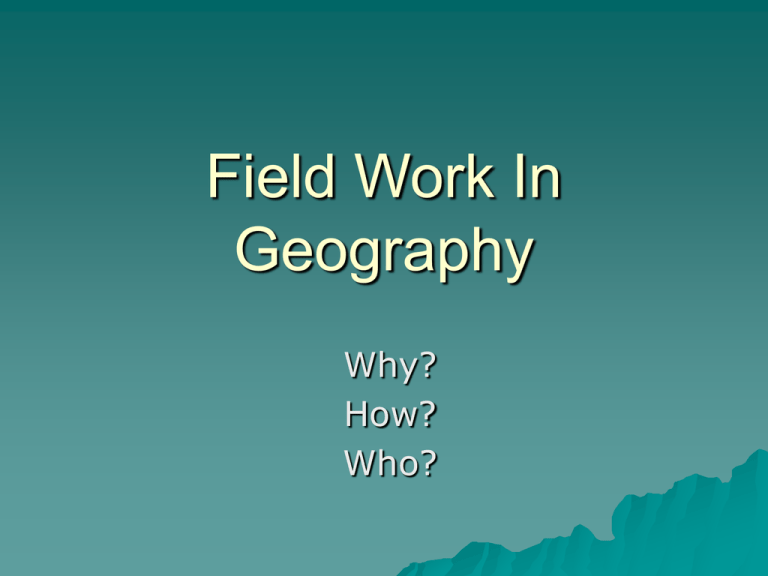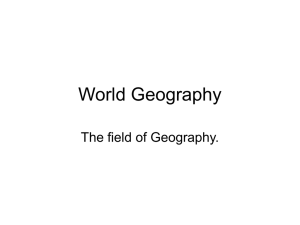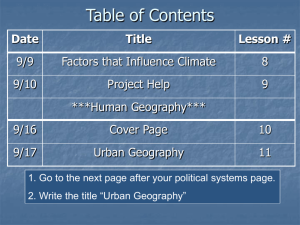Field Work In Geography
advertisement

Field Work In Geography Why? How? Who? The Science of Geography ... What and Why And who cares? With quotes from: • The Education of a Geographer Carl Sauer • A Life of Learning D.W. Meinig EARTH... fundamentally the only planet we have explored… GEOGRAPHY Is the science of describing this planet… literally, “Writing about Earth” SUBJECT MATTER From the Greek Language “geo” = Earth “graphia” = description or depiction Eratosthenes, a 3rd century B.C. Greek Scholar and chief librarian at the famous Library of Alexandria was perhaps the first person to use the term “Geography.” DEFINITIONS The world and all that is in it. Spatial perspective on people, places and environment. Geography is a social science that focuses on the spatial distribution of human and physical phenomena. The science and art of understanding the spatial relations among people, place, and environment. Geography is the study of pattern and processes associated with the Earth. The focus of the geographer is on spatial patterns and how phenomena that share common space interact spatially. DEFINITION Geography is the study of people, places and environments. But more than that, it is a way of looking at the world and asking why it works ( or doesn’t work ) and the way it does work. It is more than where, but why there. It is looking at issues from a spatial perspective and inquiring about them. Why What is Where? and Who Cares? An alternative definition of ‘geography’ developed by Dr.s McKnight and Strong during a snowball fight along the empty streets of Washington DC. “... The geographer partly is born ..” “Despite the line breeding now available by extensive series of courses in geography, running from the freshman year to the Ph.D., we still get much of our best blood from those who come from quite other academic stocks and backgrounds. These join us not because they have been inadequate in their previous commitments but because it took time for them to find their place over on our side.” [Geography] does not fit comfortably into modern academic structures, and has suffered for it. To the not uncommon question “is geography a physical or a social science?” almost all geographers would answer “both.” DWM “It is about as difficult to describe a geographer as it is to define geography” Ms. Lisa Keys-Mathews Assistant Professor of Geography Dr. William Strong Department Chair Professor of Geography “We are odd creatures. Geography is ...not what I do for a living, but what I do with my life. The born geographer lives geography every day.” dwm Dr. Mike Pretes Assistant Professor of Geography Dr. Greg Gaston Associate Professor of Geography Dr. Francis Koti Assistant Professor of Geography “The geographer and the geographer-to-be are travelers, vicarious when they must, actual when they may. They are not of the class of tourists who are directed by guide books over the routes of the grand tours to the starred attractions, nor do they lodge at grand hotels. (much to the dismay of my dear wife!) When vacation bound they may pass by the places one is supposed to see and seek out byways and unnoted places where they gain the feeling of personal discovery. They enjoy striking out on foot, away from roads and are pleased to camp out at the end of the day.” The Education of a Geographer Carl Sauer “Travel is, of course, an important part of a geographer’s learning “ D.W.Meinig A Life of Learning “…I am become a name; for always roaming with a hungry heart.” Much have I seen and known; cities of men and manners, climates, councils, governments, myself not least, but honored of them all; … I am a part of all that I have met; Yet all experience is an arch wherethrough Gleams that untravelled world, whose margin fades For ever and for ever when I move.” Ulysses Alfred Tennyson “…Death closes all: but something ere the end, some work of noble note, may yet be done, Not unbecoming men that strove with Gods. Come, my friends, 'Tis not too late to seek a newer world. Though much is taken, much abides; and though we are not now that strength which in old days Moved earth and heaven; that which we are, we are; One equal temper of heroic hearts, Made weak by time and fate, but strong in will to strive, to seek, to find, and not to yield.” Ulysses Alfred Tennyson The “geographic eye” Learning to SEE space and spatial relationships. An important part of training this skill is learning to communicate spatial relationships…. “There is, I am confident, such a thing as the "morphologic eye," a spontaneous and critical attention to form and pattern.” Carl Sauer Education of a Geographer “An innate aptitude to register on differences and similarities is joined to a ready curiosity and reflection on the meaning of likeness and unlikeness.” “Some of us have this sense of significant form, some develop it (and in them I take it to have been latent), and some never get it.” Field Work is an essential component of the Science of Geography It is impossible to accurately describe the Earth without actually observing the Earth! Well designed field observations are very powerful scientific tools “…the principal training of the geographer should come, wherever possible, by doing field work” “…I like to think of any young field group as on a journey of discovery, not as a surveying party.” “… Such excursions and field courses are the best apprenticeship….” “…the study of landforms … is at the very heart of our being.” “When we dropped land forms as our business, we lost a major stimulus to get into the field,to see and think, to state and solve problems” “Being afoot, sleeping out, sitting about camp in the evening, seeing the land in all its seasons are proper ways to intensify the experience, of developing impression into larger appreciation and judgment” Essentials for Geographic Field Work A well developed ‘geographic eye’ Curiosity A passion to understand Tools for systematic observation The field notebook.... – A mechanism that serves to strengthen the memory of the observer – Where was I? what day was it? What did I observe? – The field notebook is THE tool that conquers the failings of memory What does a field notebook look like? A field book can take a wide variety of forms.... The Forks of the Missouri sketched by Capt. Wm. Clark.. Note the grid base, the transect data and the features sketched along the river (bluffs, meanders, islands etc.) OOPS!! Damage and lost data.... The previous picture is of a portion of my field notes from July 2006 Written in pen on a spiral notebook, which worked fine.... Until, later in the trip the notebook shared the bottom of my pack with a water bottle and a very large rock (a piece of pumice about the size of a football) I was able to recover all the vital data... But the lesson was clear... Don’t be cheap with a field book!! The best choice for me is a 4X6 Write in the Rain notebook and a pencil.... Taking good field notes Develop a style, a format that you are comfortable with Record everything, don’t trust your memory Sketches are extremely valuable as part of your field observations Make the field notes a habit that you practice constantly. Format for field notes The nature of the project will be the primary driver for the amount and type of information included in the field notes. A plane table map with a high degree of accuracy will require different notes from a trans-contentintal transect. Format for field notes The format of field notes will vary from individual to individual Location can either be descriptive e.g. “collier glacier” or more precise using maps/GPS… again the needs of the project will be the primary determining factor Always include date/time/and a brief notation of conditions. Photography While I will force you to begin sketching as part of your observation/data recording process... A camera can be a VERY useful tool! I am more photographer than note taker or sketch builder.... What to look for in a camera? Reliability – You have to be able to count on the camera Large Storage media – Extra cards Easy Maintenance – Standard batteries are a plus – Avoid little shutter flaps and other dust catchers Read reviews, talk to people, and carry a spare! Other tools in the field.... Location and direction – Compass – GPS – Plane Table Elevation and slope – Brunton transit – Builders Level – Total station Other Tools in the Field (contd.) Soil and Rock – – – – – Rock hammer Acid Ph meters Munsell color chart Etc. – – – – – Collecting bottles DO meters Secchi disk Tree coring tool Etc. Water and Biotic conditions Subsurface conditions A sub-class of field observations are those that utilize various tools to “see” beneath the surface.... – GPR (Ground Penetrating RADAR) – Electrical Resistance Imaging – Seismic Data Site 2: Known Glacial Ice Site 1: Suspected Ice Cored Moraine Sketch Mapping Like Sketching, a sketch map gives a geographer the opportunity to selectively present information. A sketch map can easily be seen as a perceptual map… how does one perceive the world?… this is embodied in a sketch map. Sketch mapping is graphic communication in its purest form. Although very rarely considered, the basic rules of cartography should be remembered. Scale, direction, angular fidelity, symbolism, simplicity are all useful to remember. These are the maps you sketch on the back of a napkin to give someone directions…. Auto-biographical map by LKM… (from her web site) Autobiographical Map by GGG A sketch map and sketches of objects follow the same basic procedures… establish the limits of the area to be mapped Layout a basic referencing system and make sure the map follows these references Focus on the vital elements and make these the primary focus of the map Label features The Hundred Acre Wood




